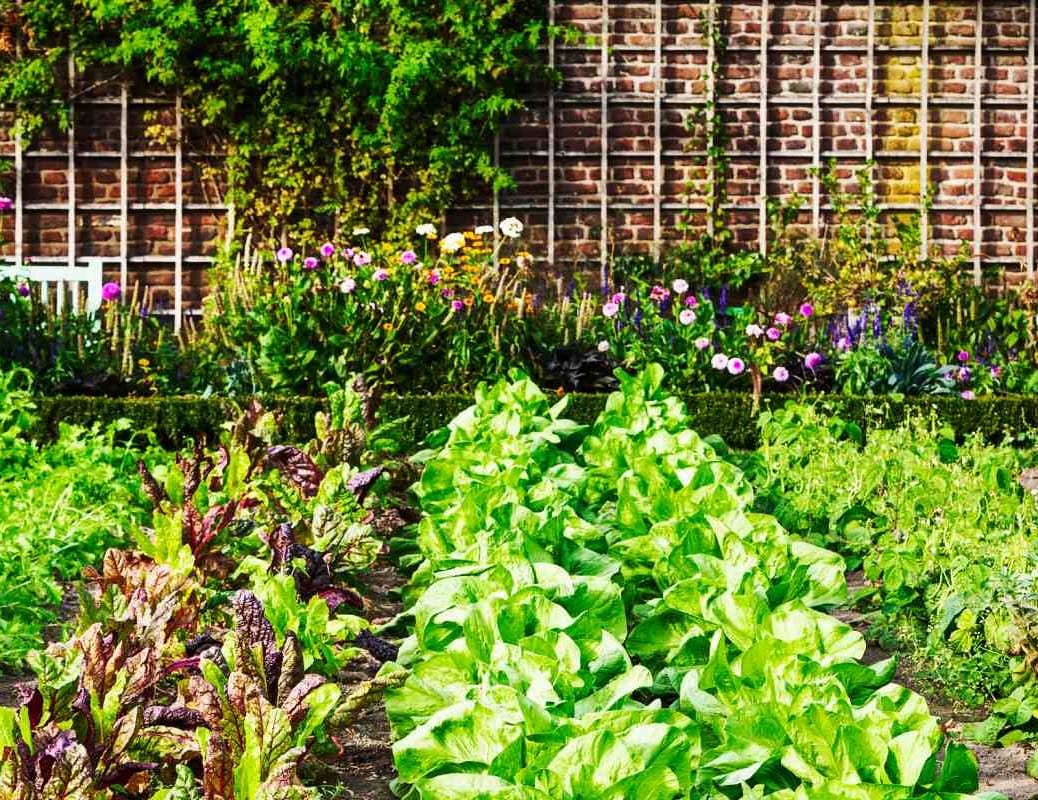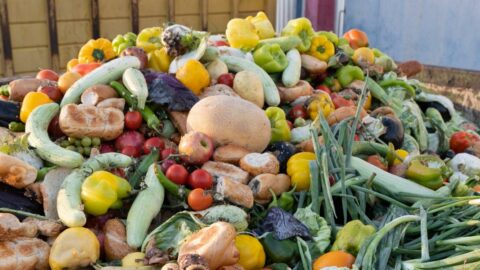If you’ve been around the “green” parts of the web, you’ve probably heard the term “urban garden,” but may not know what it means. The term describes any kind of growing activity that’s not on the usual rural farmland, in a more populated area than the usual crop growing areas.
An urban garden can be anything growing in a windowsill or patio by apartment and condo dwellers to suburban families raising food crops in their backyards. There are also rooftop gardens for those lucky enough to have the right space. Many schools have started on-campus gardens to teach children where their food comes from, and gardening skills they can use. Some inner-city neighborhoods have community gardens that allow residents to use otherwise vacant and abandoned land. They can offer fresh, locally-grown produce for neighbors, especially those in need.
Some urban gardeners expand into urban farming, using their small plots of land to raise chickens, rabbits and bees. (Cows, sheep and horses require a lot more land than a suburban plot.) But before you decide venture into livestock, check your local zoning laws. It’s one thing to grow your own salad greens, and another to keep live animals that aren’t pets in an urban or suburban area.
The smallest spaces may have a place for you to have plants. Even if you’re not growing herbs, you may have enough light for houseplants, some of which could be vegetables or fruit-bearing, depending on the variety.
What’s Your Urban Gardening Goal?
Many people have different ideas about their urban gardening, and what to do with the results. If you’re gardening for the first time, it may be worth it to see what you can grow, just to get started.
Before you spend any money, think about:
- Are you going to just have a few flowering plants or a few herbs for your own use?
- Can you use the space you have to grow food to supplement your (or your family’s) regular grocery consumption?
- If you have the room, will you raise crops for you and your family, or sell at the local farmer’s market?
- Do you want to venture into small livestock? Do you have enough room?
- Are there local laws and/or ordinances that may limit or prevent you from having an urban garden/farm?
Once you’ve decided what and how, it’s time to get started.
Assess Your Gardening Space
Of course, everything you do is decided by how much room you have. If you just have a windowsill, potted herbs or flowering plants are always a great idea. (If you have pets, make sure they can’t reach anything that might be toxic and knock them over.)
You’ve probably seen those hydroponic Aerogarden appliances that grow plants indoors year-round. They work great, but they can be expensive, including the replacement seed pods. If you can afford one and want one, they come with a set of seeds, and you can buy different types of seed pods later (salad lettuce, peppers, herbs, tomatoes, strawberries and even flowers.) The website also offers “grow anything” kits, which allow you to plant your favorite things in the Aerogarden, allowing them to grow from seed without soil.
These appliances are great for small plants, like herbs. But if you grow anything that gets bigger—tomatoes, peppers, cucumbers, etc.—they won’t produce much unless you transplant them into a larger environment. And of course you’ll have to be conscious of plants that have lots of roots, too, so they don’t crowd out the other seedlings.
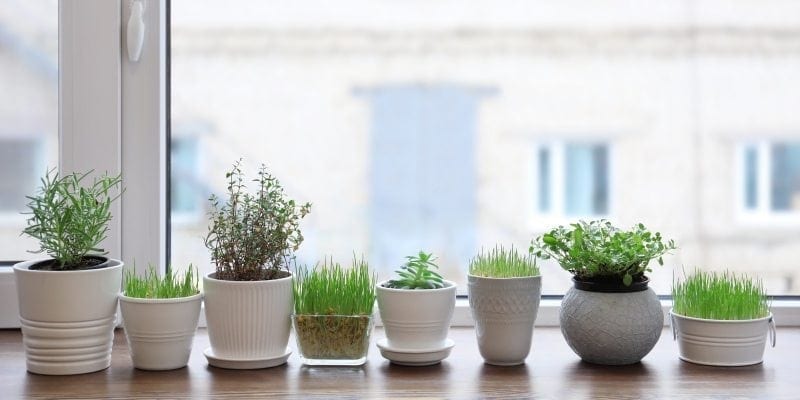
Yastremska/Bigstock
The Windowsill Garden
If you have some window space, you only need pots, a growing medium (soil, etc.) and some seeds. Get planters that fit in the window area, and start planting. If you’ve invested in an Aerogarden system, transfer your seedlings into pots and let them have the incoming sunlight.
If you like the idea of indoor hydroponic gardening, but don’t want to spend for the Aerogarden, you can learn how to create one that hangs in your window at WindowFarms’ website. Using bottles and a pump system, this DIY garden takes an afternoon to create. It’s customizable to your window size, and you’ll be able to start producing organics in your own space for yourself.
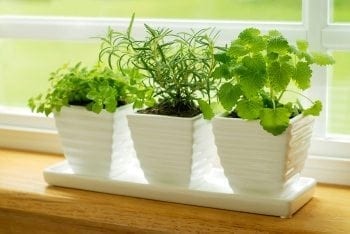
Marjoram, Rosemary, and Lemon Balm. Carly Hennigan/Bigstock.
For a small herb indoor garden, any one (or more) of these herbs are well suited to windowsill growing:
- Chives
- Basil
- Thyme
- French Tarragon
- Parsley
- Cilantro
- Mint
- Sweet Marjoram
- Sage
- Dill
If you have some outdoor space, Balcony Garden Web also offers these ideas for using Command Hooks for your garden, including growing herbs vertically in your kitchen windows.
If you have a large inset window that you can add small shelves into, this vertical window greenhouse can also get you started gardening indoors. Garden Design Magazine also has instructions on outfitting a bay window with additional shelving for growing small pots.
The Patio Garden
A patio with good sunlight is also an excellent place to grow plants, even edible ones. Whether you have dirt to dig up and plant in, or nothing but slab, container gardening is a great choice. Milk crates are one of many types of containers you can use to start planting. Whatever you chose to plant in, make sure there are drain holes to prevent overwatering and root rot.
Since it’s smaller than the usual plot of land, you’ll have to carefully consider what you’ll be growing, what you have space for, and how. You won’t have room for any wasted space, so make it count. If you have a fence, you’ll be able to practice some vertical gardening with vine bearing plants (roses, peas, etc.) giving your pot-bound plants more room to thrive. If you’ve started a vegetable/herb garden indoors, think about where everything will go once you’re transplanting them into the outdoor environment. Choose vegetables that are better suited for containers. Edibles with words like “dwarf,” “pixie,” “patio,” and “baby” in the name is a good bet.
If you’re going for color instead of veg, don’t plant every color of the rainbow. Start with two or three colors with multiple textures (roses, daisies, etc.) You can add an accent color later, or change out plants that aren’t thriving or not attractive on your patio. Plants should last at least two seasons, and possibly three or four depending on your climate.
Do you have a fair amount of hardscaping (stone, tile, walls, etc.)? A container garden is a great way to make the area more comfortable and green. If you’re lucky enough to have built-in flower boxes, take advantage of them! Whether you plant sweet-smelling flowers for aesthetics, herbs or other small vegetation, the roots will be well-protected by the stone construction. Other plants will make the area comfortable.
Remember that whether you want a vegetable/herb garden or just some greenery to enjoy, they will need a fair amount of sunlight every day. You’ll need to water and fertilize your plants, too.
Fast Company’s website also has some tips for small-scale growers, both window and patio, and so does Mashable.
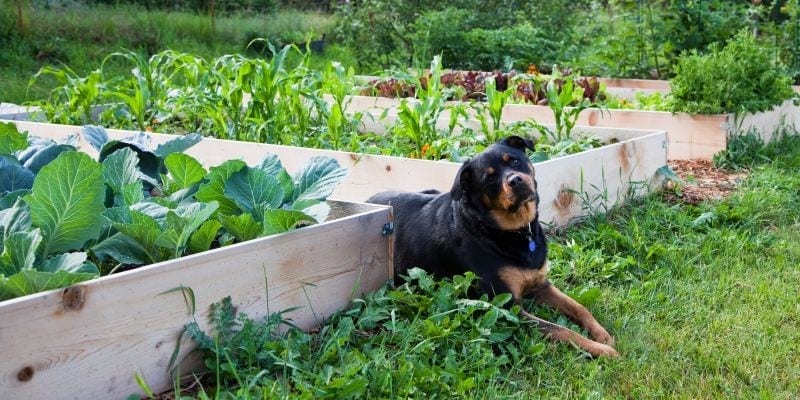
TamiFreed/Bigstock
The Backyard Garden
During World War II, Americans were encouraged to start and grow “Victory Gardens” to help with the war effort during rationing. Growing and preserving your own food during rationing meant more food was available to send to the troops overseas. (Even today, if you’re on food stamps, you can buy seeds and some plants to grow your own food.)
Backyard gardening is most popular type of urban gardening, limited only by how much ground you have available for planting. You can choose a small part of your backyard, or use the entire plot for planting. Make sure there’s ample sun and water available, and your plants won’t be crowded in.
Start with a plan on paper, and observe the sunlight during the day. Is there enough back there to sustain your garden? Can you get water to it with a hose, or will you need to transport it with a bigger vessel? Figure out what kind of plants you want to grow—vegetables, fruit trees, herbs, flowers, or a combination of all of them. (Flowers will bring in more bees to help pollinate many of your plants.) Raised beds are also an option if you’re not keen on digging up the sod, or you have trouble working at ground level.
Will you be raising crops for your family’s consumption, or do you plan to sell some at the local farmer’s market? Many small businesses have started with backyard operations. If you’re interested in selling, check with your local farmer’s market and local municipalities on rules and regulations regarding selling your crops.
Gardener’s Supply Company has more information on growing vegetables in containers on their website.
The Front Yard Garden
The home garden trend returned when the economy started to downturn a few years ago. Many families began growing their own food and looking for ways to maximize their growing capacity. With jobs and hours cut, growing food to supplement their regular grocery shopping became more attractive to urban dwellers and suburbanites nationwide, especially those with children.
You probably realize that the front yard is probably the sunniest place on your property. The rise of social media sites like Pinterest and YouTube helped stoke the front yard garden idea, with designs and concepts freely passed around. Why not dig up your front yard and grow avocados, lemons, apples and figs?
Well. . .not so fast.
If you live in an area with a homeowner’s association (HOA), you may have some serious opposition to a front yard veggie garden. These organizations were established to “keep the peace,” with neighborhoods agreeing to allow the HOA to regulate how you maintain your own property. Outlaw Garden offers this 10-point guide to successfully gardening while dealing with an HOA.
Unfortunately, as front-yard gardening flourished, many local municipalities began passing and enforcing laws prohibiting these gardens. Some enforcement officials have gone so far as to walk onto private property and pull up carefully tended plants from an edible landscape. So it’s best to investigate your area’s laws and ordinances before starting a front-yard garden.
If you’re not under the hard line of an HOA, or your local city or town allows it, you shouldn’t have a problem—but always check before you start planting. If you’re a proficient gardener that can keep the garden looking good and producing, you may not experience any pushback from neighbors.
If you’re able to start one, Burpee has advice on their website. Gardener’s Supply Company also has a front-yard garden at their company offices, and offers these tips on starting and maintaining one.

Odua Images/Bigstock
The Roof Garden
In areas like New York City, residents are as far away from gardening and farming as you can get—especially in high-rise buildings. But many still like to garden, and do as much as they can. Who can blame them? Deer can’t get to the plants and chew them down to the ground. But a rooftop garden can have more tangible benefits.
In addition to creating more green space, a garden on top of your house or building can also help in the heat of summer. An urban roof gets a lot hotter than plants and vegetation. Putting plants on your roof can not only help control heat in summer, it can protect your roof from wear and tear from the heat. A rooftop garden can also keep the temperature down inside, easing the burden on air conditioning systems—and the electric grid. It also helps manage rainfall, helping with storm drainage systems.
Containers are the best way to get started on your rooftop, with lighter containers being the best option. Drought-tolerant plants are recommended, since they’ll get hotter than they would on the ground, and require more watering. You’ll also need to consider how much weight your roof can tolerate. A plastic pot containing soil and water will weigh less than a terra cotta one.
Like the front-yard garden, your area may have specific laws or ordinances regarding rooftop gardens. Before you start adding plants, make sure you can have them up there. Building codes, landlord rules and other restrictions may prohibit the roof for any type of use, depending on where you live. There are multiple considerations before you can start this type of garden, so be sure you can before you spend any money.

RTavani/Bigstock
What Kind Of Gardening Supplies Do I Need?
Gardening supplies are as close as your neighborhood hardware store or big-box retailer. If you have a hometown store that sells plants and other supplies, you may also find someone who you can talk about gardening with. (Big-box retailers don’t always have subject matter experts available.)
Urban gardening and urban farming have become so popular that even kitchen store Williams-Sonoma now has an entire section of their website dedicated to the agrarian lifestyle. Included among the copper pots from France and high-end blenders are chicken coops, beekeeping equipment, raised and vertical beds, garden tools, seeds and DIY kits for everything from starting seeds to making beer and spirits. But you don’t need to spend a fortune on supplies and equipment, especially if your first foray into gardening will be herbs in a windowsill pot.
When is The Best Time To Start Gardening? Right Now!
There’s never a bad time to start going green and growing your own food. You’ll be able to grow organically, eat healthier foods and have pride when you cook.

Gardener showing off beets in an urban community garden. Photo Credit: evren photos/Bigstock
Whatever you have for space, begin your own urban garden with what you have. If you’re in a small apartment or condo, you can start small and learn as you go. There are plenty of resources online at the touch of a search engine to guide you through the zone you live in, what grows where you live, and what you can expect. The EPA offers this guide to starting a community garden or expand your urban agriculture, as well as additional resources. UrbanFarming’s website has more resources for helping people grow more food to combat hunger and poverty worldwide.
Think about how much time you have to spend in your garden, and if you have family members, how much they can help you dig, prune, water and anything else you need. If you’re by yourself, give yourself time to take care of everything, or you’ll be disappointed in your harvests.
When the flowers bloom, the herbs get big enough to cut and use, and your fruit and veg start appearing, you’ll have a nice garden that provides you with flowers, herbs and/or other edibles, and you can show off and talk about with pride.
Photo Credit Top image: firina/Bigstock
- How to Create an Urban Garden that Fits in Your Space - May 9, 2022
- Organic Baby: Best Baby Formulas and Baby Care Products - May 9, 2022
- Going Green: Light, Medium and Deep Green - May 9, 2022
